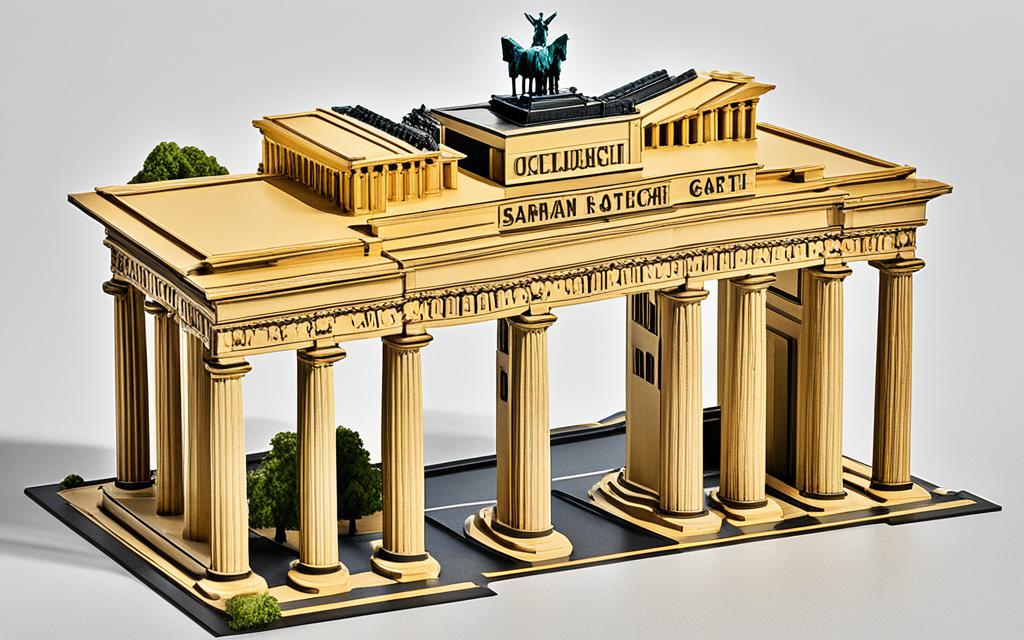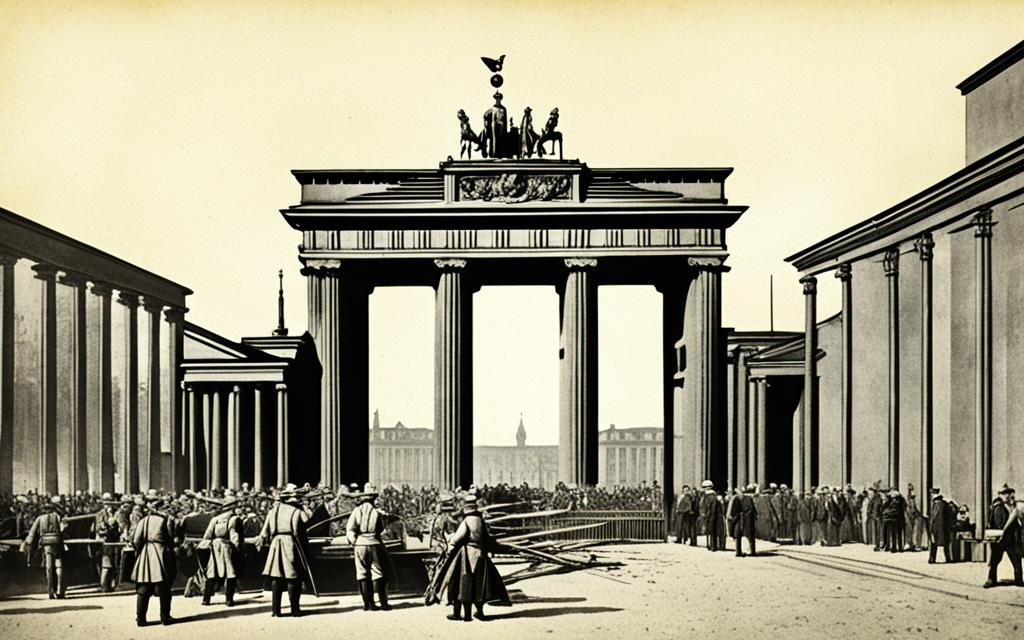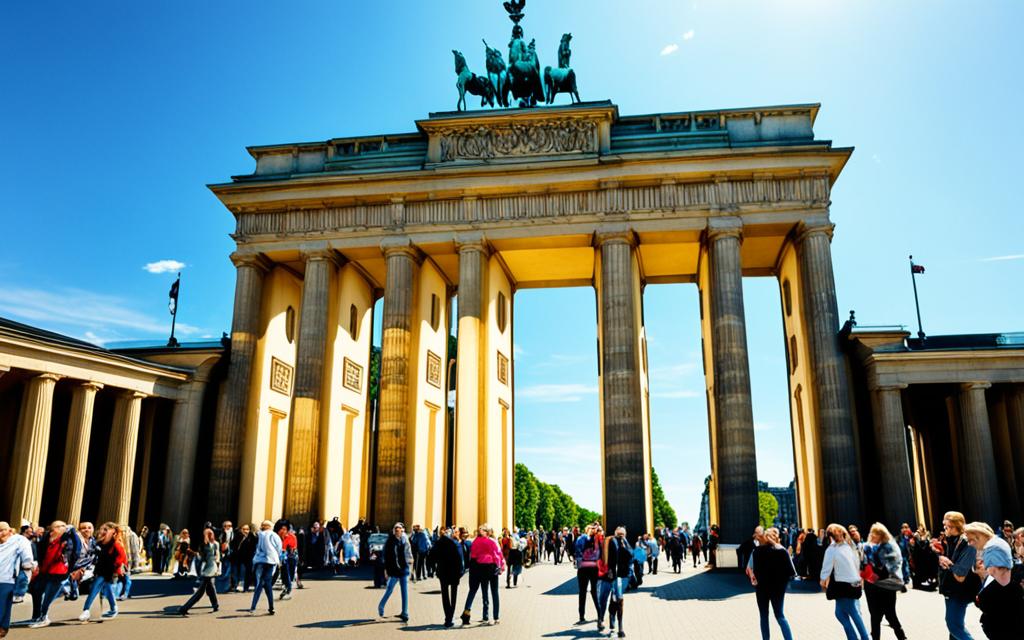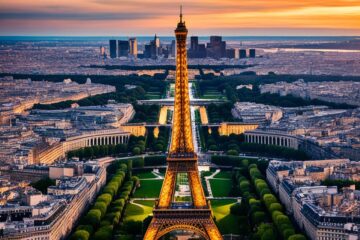Standing before the grand Brandenburg Gate, I felt its presence and history. Its stunning Neoclassical style and tall columns tell Germany’s story. This key Berlin landmark, built in the 18th century, has seen many changes.
Originally part of the Prussian reign, then the Berlin Wall divided the nation. Finally, it stood witness to the reunification of Germany. The Brandenburg Gate symbolizes Germany’s strength and unity.
Key Takeaways
- The Brandenburg Gate is an iconic 18th-century Neoclassical monument located in the heart of Berlin, Germany.
- It has become a symbol of Germany’s turbulent history, witnessing the nation’s transformation from Prussian rule to reunification after the fall of the Berlin Wall.
- The Brandenburg Gate is one of the most recognizable landmarks in the world, playing a significant role in shaping Germany’s cultural and political landscape.
- The gate’s Neoclassical design reflects the Prussian legacy and the architectural trends of the 18th century.
- The Brandenburg Gate has emerged as a powerful symbol of Germany’s resilience and its transition from a divided past to a unified future.
Introduction to the Brandenburg Gate
The Brandenburg Gate is a famous Berlin landmark and German monument. It stands for the rich historical significance of the country. This iconic structure was built in the late 18th century. It has seen the story of Prussian history, showing both division and reunification for the Germans.
Berlin’s Iconic Landmark
The Brandenburg Gate is at the west end of the Unter den Linden boulevard. It’s a Neoclassical triumphal arch, making it an iconic part of Berlin. The gate’s grand presence makes it a top tourist attraction. Visitors from everywhere come to see its beauty.
Historical Significance
For many years, the Brandenburg Gate has seen important moments in German history. It’s been there since the Prussian era and saw the country’s division and later reunification during the Cold War. The gate shows the nation’s strength and its power to face big challenges.
The Brandenburg Gate
The Brandenburg Gate is an amazing example of Neoclassical architecture. It was created by Prussian architect Carl Gotthard Langhans. It was finished in 1791. The gate has 12 Doric columns and a big statue on top. The statue shows Victory, a Roman goddess, in a chariot with four horses.
Architectural Marvels
The Brandenburg Gate is a masterpiece of architecture. It shows the skill and detail of Neoclassical style. Its design is very balanced and grand. The columns and archway are symmetrical, showing the true beauty of this style from the 18th century.
Neoclassical Design Elements
The Neoclassical design elements of the Brandenburg Gate highlight symmetry, detailed decorations, and classic signs. They speak of the Prussian legacy and the design styles of the 18th century. The gate looks elegant and refined, showing the lasting impact of Neoclassical architectural design on Germany.

Prussian History and the Gate
The Brandenburg Gate was ordered by Frederick William II of Prussia. It aimed to symbolize peace. This gate was built in the late 18th century. At that time, Prussia had great power in the region. The gate’s style, Neoclassical design, shows a mix of Prussian and classic architectural ideas.
Prussian Legacy
The building of the gate and its history are closely linked with Prussian rule. It’s a key part of Germany’s political and cultural history. This German monument is a lasting sign of how Prussia shaped the art and buildings of the area.
18th Century Construction
Carl Gotthard Langhans, a Prussian architect, designed the Brandenburg Gate. It was finished in 1791. The gate shows off a style called Neoclassical architecture. It was very popular back in the 18th century. The gate’s look, balanced and detailed, is a clear mark of Prussian and the wider cultural styles of that time. This makes it a famous part of German history.

Berlin Wall and Reunification
The Brandenburg Gate was key during Germany’s separation and later reunification. It stood in East Germany when the Berlin Wall was built in 1961. This showed the painful divide within the country. But, when the wall fell in 1989, it became a symbol of Germany’s strength and unity.
Now, many come to see the historic Brandenburg Gate. It represents Germany’s ability to face challenges and grow stronger. The Gate’s role in German reunification keeps inspiring people from all over the world.
The Brandenburg Gate, a top site in Berlin, shows unity across Germany. It’s a symbol of the country’s rich culture and spirit. Tourists visit to see its iconic history and stand in awe of its powerful message.




